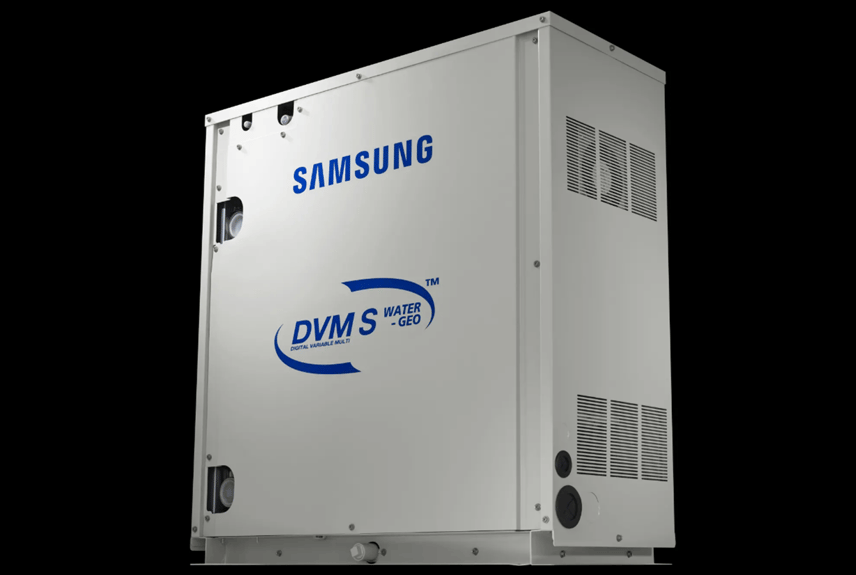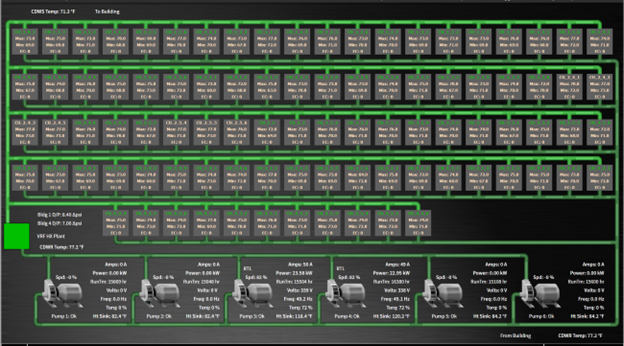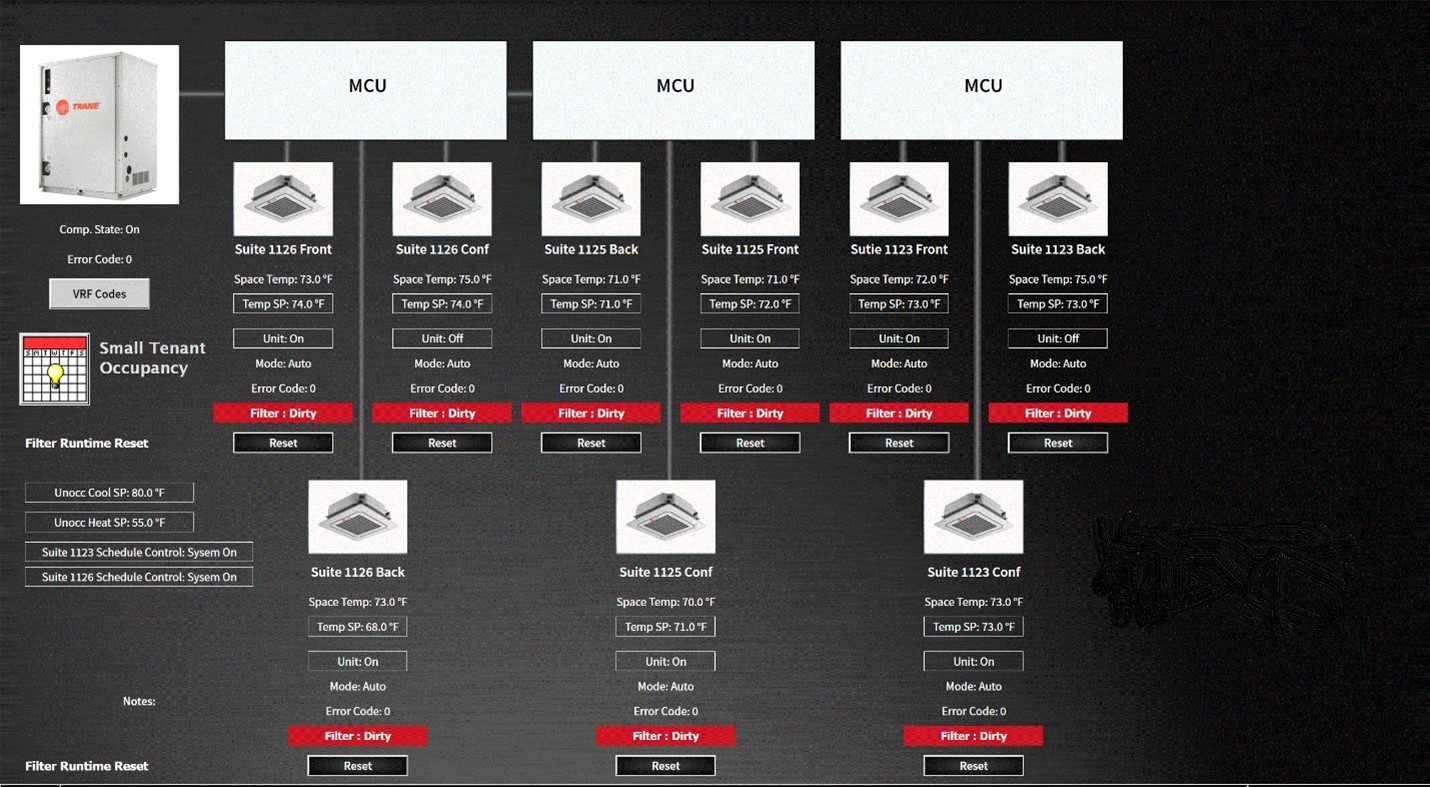How Optimizing Variable Refrigerant Flow Cooling Systems can Save Building Managers on Energy Usage
EES is very active with several Variable Refrigerant Flow, VRF, cooling systems’ manufacturers. In this article the condenser-water optimization on Samsung equipment will be discussed.

Samsung makes VRF condensers in water-cooled (like the one shown), or air-cooled like the ones we described in the Pier Village Blog.
Water-cooled systems have the advantage of being able to be placed in closets inside the building, but they also have the disadvantage of needing condenser water piped to them. Having a water-cooled system indoors also shortens and simplifies the refrigerant piping. They are also easier to service in any weather. When set up properly, each condenser unit has a constant-rate flow valve and an isolation valve on the condenser water line. The condenser also has a contact to say when it needs condenser water. There is a flow switch to make sure there’s water-if there isn’t, the unit will not start.
For some reason, we have seen many installations where the valve is not installed and the contact is not used. We always install the valve on new installations and strongly recommend them on systems that we come across (usually when the client is dissatisfied with their old BMS company).
By making use of the contact and controlling the valve with the system, we are empowering the condenser unit to be judicious in choosing when it needs condenser water. Basically, when the compressor is running, it needs condenser water. When it shuts down during periods of unoccupancy, it doesn’t.
When the valve is closed, no water flows to the compressor/condenser. We use differential pressure measurement (D/P), 2/3 the piping distance toward the end of the line away from the pumping equipment, to determine how much we need to run the condenser pumps. As units come online, their valves open and the D/P drops. We compensate by increasing the speed and possibly the quantity of pumps online. As units shut down, we reverse the process.
So, in a building with more than one such condenser, it is smart to close the valve on units that are off. That optimizes pumping of condenser water to the units that need it and backs down the pump energy required during periods of reduced occupancy.
EES designs, manages, and maintains the controls in a large (2.2 million square feet) building in NJ. If you’re interested in learning more, you can read this blog.
As shown in the screenshot below, the kW required to pump the condenser water varies, under our direction, from 7 kW at night to 54 kW during maximum operation. We change the speed to control the pressure and the square of the speed is related to kW.

At this particular facility, the pumps shown above go out to the VRF equipment and the heat exchangers isolate the water chemically from the cooling tower water that is also used for the chiller plant that serves non-VRF areas of the building. We throttle the valve on the heat exchanger, tower side, to prevent “hogging” the condenser water from the tower so that the chillers can have some too.
During the cooling months, we modulate the heat-exchanger valve, but set a minimum of 20% at night. This allows a few things. First, it keeps the modulating valve from adjusting too much in an effort to extend its life. Second, we remove the maximum amount of residual energy from the piping loop to let the systems cool and run as efficiently as possible. In winter, when the tower is in “free cooling”, we limit the discharge temperature of the VRF side of the heat exchanger to 65 degrees Fahrenheit to prevent the pipes from sweating and causing leak/flooding issues throughout the building.

The screenshot above shows the one-line of the condenser piping;, the little green square bottom-left expands to the previous screenshot. Each of the other squares represents a single system within the building. One such is in the next screenshot.
Another thing that EES has designed in to our VRF control is night setback. Everyone knows about night setback. Everyone who pays for their own heat or air conditioning at home has it (or really should). VRF equipment, out of the box, doesn’t.
If one leaves a VRF indoor unit in “auto” (the recommended setting), and changes the temperature, say in the summer from 72 to 85 to be “unoccupied”, instead of the system drifting until it may get there, it aggressively turns to heat mode and drives the room to 85 degrees. Not efficient.
Our supervisory logic turns the VRF units off during periods of unoccupancy and monitors the space temperatures against an unoccupied setpoint, one for cool and one for heat. If any of the rooms tied to the system in question get out of range, we start up the system and let each room run with the occupied setpoint until the temperature extreme is alleviated

Above is a typical VRF system. It shows a Trane-logoed Samsung condenser unit on the left, three mode control units (MCU), and several indoor units. The job of the MCU is to marshal either cold refrigerant to areas wanting cooling or hot refrigerant (waste from a room that was just cooled) to a room that wants heat. In this way, the waste heat from cooling goes to heating instead of to the condenser water and the heating is for free.
A properly designed installation, with loads that expect both heat and cooling at the same time, connected to the same unit, will be very efficiently serviced. Obviously, it requires some upfront knowledge and information at the time of the design to maximize the efficiency of the installation. It is very expensive to change later.
There are systems that are heating-only or cooling-only. These have a lower installation cost but do not do any energy recovery. As always, it depends on the need of the end user and requires that the designer know the options and the criterion for their selection.
If you have a VRF system or are thinking about getting one, make sure you have someone, like EES, who knows what they are doing so that the system runs optimally through all the seasons of the year.
Reach out if you’re interested in having a system that runs efficiently and saves you money.

